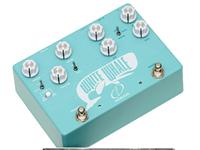Tell Me About: Karplus Strong Synthesis
US Chris Randall of Audio Damage Explians 13/06/16| MP4 | 9:52 mins |
Some synthesis methods are pretty abstract, and while many people grasp the concept of subtractive synthesis, its what 90% of current synthesizers and modules are based on, there are other synthesis types and methods that are less known. Karplus Strong is one of those - defined as a physical modelling technique primarily geared towards the emulation of string vibrations. If you are an Apple Logic user, you may have come across it in software with the included Scuplture instrument, but in hardware, its more convoluted to construct, requiring a number of discrete elements.
We had a chat with Chris Randall of Audio Damage Inc who's been working on a module called Proton, that combines all of the elements of KP with a few twists of their own. Typically the algorithm is best suited to the emulation of resonating strings such as guitar, banjo and koto type sounds.

Karplus Strong Theory (Via Wikipedia)
- A short excitation waveform (of length L samples) is generated. In the original algorithm, this was a burst of white noise, but it can also include any wideband signal, such as a rapid sine wave chirp or frequency sweep, or a single cycle of a sawtooth wave or square wave.
- This excitation is output and simultaneously fed back into a delay line L samples long.
- The output of the delay line is fed through a filter. The gain of the filter must be less than 1 at all frequencies, to maintain a stable positive feedback loop. The filter can be a first-order lowpass filter (as pictured). In the original algorithm, the filter consisted of averaging two adjacent samples, a particularly simple filter that can be implemented without a multiplier, requiring only shift and add operations. The filter characteristics are crucial in determining the harmonic structure of the decaying tone.
- The filtered output is simultaneously mixed back into the output and fed back into the delay line.
- Karplus Strong Synthesis (wikipedia)
- AudioDamage
More From: TELL ME ABOUT
Even more news...
Want Our Newsletter?
More Stories:
More...
Older Music Machines & the People Who Still Use Them
Developments for Korg's instrument have been slow but promising.








